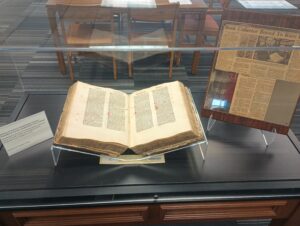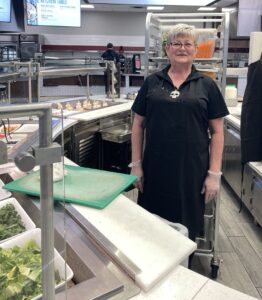During the summer, Oklahoma Christian University experienced major changes, including office relocations and renovations across campus. One of these transformations included the relocation of the Kyle Seitsinger newsroom. Seitsinger was a student at Oklahoma Christian in-between calls to military duty. He enlisted as a senior in 2000, double majoring in Spanish and Journalism. While serving in Afghanistan, Seitsinger tragically lost his life when a weapons cache exploded unexpectedly. He is the only Oklahoma Christian student who was killed in action while serving his country. Later, his family funded Oklahoma Christian’s original newsroom in Seitsinger’s honor. The updated newsroom will feature the Heritage Collection, providing historical context that once laid the foundation to what not only journalism is today but what Talon News is today. The Heritage Collection comprises close to twenty famous front pages from a variety of newspapers covering all manner of political events and natural disasters over a 70-year period. The space will be equipped to broadcast ongoing news channels.
Dr. Philip Patterson, primary sponsor of Talon News, wants to broadcast news with different biases.
“I plan to have CNN, Fox News, MSNBC and ESPN streaming at all times. I want to have both conservative and liberal media playing,” Patterson says.
A milestone that marks both necessity and innovation is the decade anniversary of Talon News being a digital-only publication. Following the retirement of its longtime printer, Talon News was forced into the digital world in 2014 the Monday following Spring break. Since this change, Oklahoma Christian has saved thousands of dollars every semester. “Printing is your largest single budget after salaries, printing also means that stories have to come out even, headlines have to come out all the way across. It just means a lot of things,” Patterson says. “I don’t know why we would have to worry about a story being two inches too short.”
Editor in Chief of Talon News, Meredith Madison, touches on the issue and how it affects her role in leading a digital publication.
“Although at times I wish we had a physical copy of our publication, I believe that as our world moves more towards digital reading, we have to move along with the times,” Madison says. “People are more willing to read something they see online rather than a physical copy. As for historical purposes, an online publication allows us to store breaking campus news better than a physical copy could.”
Despite Oklahoma Christian’s smooth transition to digital publication this has not been the case for other universities in the area, like the University of Central Oklahoma. After 122 years of The Vista’s print publication, the University of Central Oklahoma switched to publishing strictly digital content starting Fall 2025. Since making this transition, the university has faced immense controversy.
One reason for the controversy stems from the fear that switching to digital content would take away the experience of hands-on opportunities to learn the physical process of print publication. However, the main concern for the transition was how it would affect the publication’s readership.“…there are many advantages to moving online. A few reasons being more readership, multiple formats for stories, and a wider variety of experience related to the ever-changing world of journalism,” Madison says.











Be First to Comment